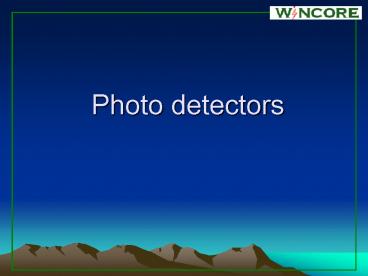Photo detectors PowerPoint PPT Presentation
1 / 18
Title: Photo detectors
1
Photo detectors
2
Optical Receivers
- Optical receivers convert optical signal (light)
to electrical signal (current/voltage) - Hence referred O/E Converter
- Photodetector is the fundamental element of
optical receiver, followed by amplifiers and
signal conditioning circuitry - There are several photodetector types
- Photodiodes, Phototransistors, Photon
multipliers, Photo-resistors etc.
3
Photodetector Requirements
- High sensitivity (responsivity) at the desired
wavelength and low responsivity elsewhere - Low noise and reasonable cost
- Fast response time ? high bandwidth
- Insensitive to temperature variations
- Compatible physical dimensions
- Long operating life
4
Photodiodes
- Due to above requirements, only photodiodes are
used as photo detectors in optical communication
systems - Positive-Intrinsic-Negative (pin) photodiode
- No internal gain
- Avalanche Photo Diode (APD)
- An internal gain of M due to self multiplication
- Photodiodes are reverse biased for normal
operation
5
Basic pin photodiode circuit
- Incident photons trigger a photocurrent Ip in the
external circuitry by pumping energy - Photocurrent ? Incident Optical Power
6
PIN Photodiode
- It is a junction diode in which an undoped
intrinsic ( i ) region is inserted between
relatively thin p region and relatively thick n
region. - Diode is reverse biased so that the entire i-
region is depleted and has a strong electric
field. - Light absorbed in intrinsic region produce free
electron hole pairs, provided that photon energy
is high enough. - These carriers which are responsible for
photocurrent are swept across the region with
high velocity and are collected across the
reverse biased junction. - This gives rise to a current flow in the external
circuit called the photocurrent.
7
pin energy-band diagram
A particular semiconductor material can be used
only over a limited wavelength range
8
pin energy-band diagram
Cut off wavelength depends on the bandgap energy
Cut off wavelength for Si is about 1.06 µm and
for Ge it is 1.6 µm. For longer wavelengths the
photon energy is not sufficient to excite an
electron from the valence band to the conduction
band.
9
Materials of construction
- The material used to make a photodiode is
critical to defining its properties, because only
photons with sufficient energy to excite
electrons across the material's bandgap will
produce significant photocurrents. - Materials commonly used to produce photodiodes
include
Material Wavelength range (nm) (for good sensitivity)
Silicon 1901100
Germanium 4001700
Indium gallium arsenide 8002600
InGaAsP lt1000-3500
10
Quantum Efficiency(? )
- Quantum Efficiency (?) number of e-h pairs
generated / number of incident photons - Ip?average photocurrent produced by a
steady-state average optical power Po incident on
the photodetector - q ?is the charge of the electron
- hv?photon energy
11
Responsivity (?)
Responsivity is the ratio of photocurrent to the
incident optical power on the photodetector.
- Avalanche PDs have an internal gain M
mA/mW
IM average value of the total multiplied
current M 1 for PIN diodes
12
Responsivity
13
Signal to Noise Ratio
- For high SNR
- The Photodetector must have a large quantum
efficiency (large responsivity or gain) to
generate large signal power - Detector and amplifier noise must be low
SNR Can NOT be improved by amplification
14
Quantum (Shot Noise)
Due to optical power fluctuation because light is
made up of discrete number of photons
F(M) APD Noise Figure F(M) Mx (0 x 1)
depends on the material For PIN diodes F(M) and M
are unity. Ip Mean Detected Current B
Bandwidth
15
Dark/Leakage Current Noise
There will be some (dark and leakage ) current
without any incident light. This current
generates two types of noise
Bulk Dark Current Noise
ID Dark Current
Surface Leakage Current Noise
IL Leakage Current
(not multiplied by M)
16
Thermal Noise
The photodetector load resistor RL contributes a
mean-square thermal (Johnson) noise current
KB Boltzmanns constant 1.38054 X 10(-23) J/K
T is the absolute Temperature
- Quantum and Thermal are the important noise
- mechanisms in all optical receivers
- RIN (Relative Intensity Noise) will also appear
in analog - links
17
Signal to Noise Ratio
Detected current AC component (ip) DC
component (Ip) Signal Power ltip2gtM2
Typically not all the noise terms will have equal
weight
18
SNR
- Dark current and surface leakage current noise
are typically negligible, If thermal noise is
also negligible - For analog links, (RIN Relative Intensity Noise)

